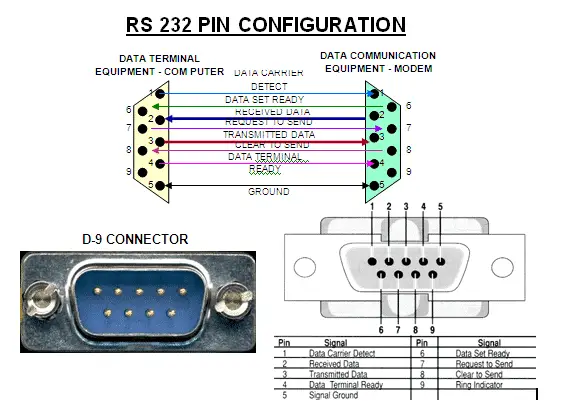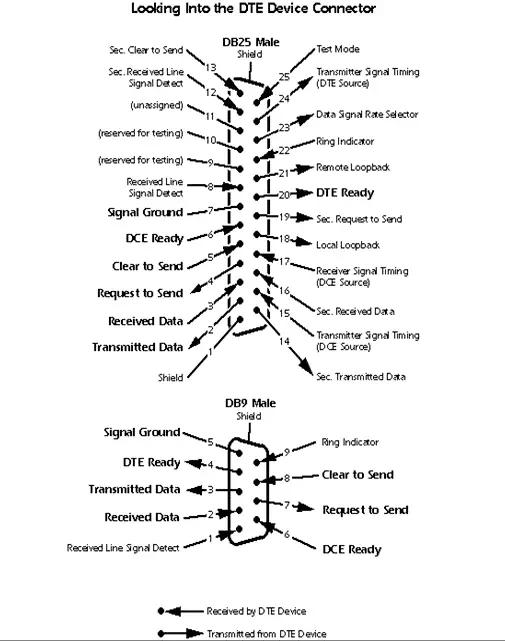Introduction
RS-232 stands for Recommended Standard 232. It is a well-established and well-known standard for serial data communication. Intended to link Data Terminal Equipment (DTE) like computers to Data Circuit-Terminating Equipment (DCE) like modems etc. RS-232 has been used since the early 1960s.
History of RS-232
During 1960s, digital communication started to rise as a means to move data between two locations — usually between a mainframe computer and a remote terminal, or even two devices other than computers. That time, Telephone lines were normally used as the medium of transmission, and a DCE (like a modem) was needed to translate the data signals for transmission.
Due to lack of a uniform interface, devices of various manufacturers had a compatibility issue, resulting in communications failures or data corruption. Realizing the necessity for a uniform, consistent, and manufacturer-neutral interface, the Electronic Industries Association (EIA) released the RS-232 standard in the early 1960s. The standard specified a uniform electrical, mechanical, and functional specification so that DTE and DCE devices could exchange data smoothly.
Design and Physical Features
RS-232 pin configuration uses a 25-pin D-sub connector (DB-25) and provides pin assignments as well as signal voltages.
The main features of RS-232 configuration are:
Signal voltages: Logic “1” is marked by a voltage in the range of −3 V and −15 V, and logic “0” is marked by voltage in the range of +3 V to +15 V.
Cable length: It provides support up to 15 meters without any loss in data rate.
Data rates: It generally supports up to 115.2 kbps. However, with increase in distance, the data speed decreases a bit.
Wiring: Pretty simple wiring. Uses a Single-ended signaling, but is prone to noise interference compared to other standards like RS-485.
Note: The first connector used was DB-25 connector. But, specifically between 1980s to 1990s, the DB 9 connector gained a lot of popularity specially in Computers.
Why RS-232 Has Lasted for Years?
RS-232 might be old if compared with USB or Ethernet, but it has several properties that makes it in service today:
Simplicity – Simple wiring and plug-and-play configuration.
Interoperability – Works with equipment from a variety of suppliers.
Reliability – Well-documented stability in industrial and embedded systems.
Low Cost – Low-cost interface components and cables.
Uses of RS-232
Even with different advanced options, RS-232 is still widely used in:
Industrial Automation – Control hardware, sensors, & PLCs.
CNC Machines – Downloading & uploading machine code.
Point of Sale (POS) Systems – Barcode readers, Receipt printers.
Networking Hardware – Console ports on switches & routers.
GPS Modules – Giving NMEA data to a controller or PC.
Modems – Old dial-up & leased line connections.
RS-232 uses in Modern Times
Now, most of the laptops & PCs do not have a built-in RS-232 port. But USB-to-RS-232 adapters and RS-232-to-TTL converters make it simple to interface legacy gear. Its work may have been changed from mainstream use to target or special purpose use. Even though RS-232 continues as one of the most successful and long-lasting communication standards stands unchallenged.
Read Also: RS 232 Signals




5redfo
I’m commenting to let you be aware of of the impressive experience my cousin’s child went through reading yuor web blog. She figured out lots of details, which included how it is like to possess an excellent coaching nature to make many people with no trouble completely grasp some multifaceted topics. You actually did more than our expected results. Many thanks for imparting those warm and friendly, trusted, explanatory and even easy thoughts on the topic to Emily.
Thanks – Enjoyed this update, can you make it so I get an email sent to me every time you publish a fresh post?
I am so happy to read this. This is the kind of manual that needs to be given and not the random misinformation that’s at the other blogs. Appreciate your sharing this greatest doc.
Your article helped me a lot, is there any more related content? Thanks!
I’m really enjoying the design and layout of your website. It’s a very easy on the eyes which makes it much more pleasant for me to come here and visit more often. Did you hire out a developer to create your theme? Great work!
Thanks a bunch for sharing this with all people you really know what you are speaking about! Bookmarked. Please also consult with my site =). We can have a link trade contract among us!
Excellent read, I just passed this onto a friend who was doing some research on that. And he actually bought me lunch since I found it for him smile So let me rephrase that: Thank you for lunch! “The capacity to care is what gives life its most deepest significance.” by Pablo Casals.